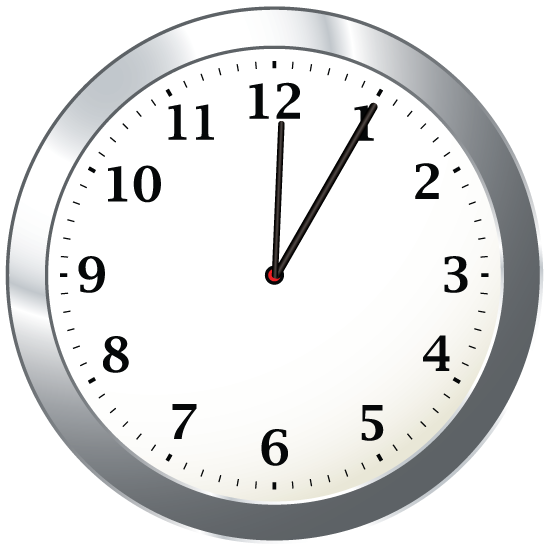
Display Title
Math Clip Art--Clock Art--Clock Face Showing 12:05
Display Title
Clock Face Showing 12:05

Topic
Time Measurement
Description
This clock face image shows the time as 12:05, illustrating the concept of minutes past the hour. The minute hand is positioned slightly past the 12, while the hour hand remains on the 12, making it an excellent tool for teaching how to read time beyond the hour mark.
Educators can use this image to demonstrate the progression of time in five-minute increments. Students can practice identifying the correct time by observing the position of the minute hand relative to the hour hand.
Math clip art like this is essential for teaching time-telling skills because it provides a visual representation that helps students understand the relationship between hours and minutes. It supports the development of time literacy in a clear and engaging manner.
Teacher's Script: "Observe this clock showing 12:05. Notice how the minute hand has moved past the 12. This means it's five minutes past twelve. Let's practice reading other times using this method."
For a complete collection of math clip art related to Telling Time click on this link: Clock Face Collection.
Video: Telling Time
To review telling time, watch this video. (The transcript is also included.)
Telling Time

The video was uploaded on 9/6/2022.
You can view the video here.
The video lasts for 2 minutes and 12 seconds.
Video Transcript
When you look at a clock, you can read the hour and the minutes. >Here is a blank clock face. Let's start by looking at the hour hand. It is the shorter of the two clock hands and looks like this.
The hour hand varies in value from 1 to 12. Here is a tour of times around the clock using the hour hand.
12 o'clock.
1 o'clock.
2 o'clock.
3 o'clock.
4 o'clock.
5 o'clock.
6 o'clock.
7 o'clock.
8 o'clock.
9 o'clock.
10 o'clock.
11 o'clock.
And back to 12 o'clock.
The minute hand is the longer of the two clock hands. This is what it looks like. The minute hand varies in value from 0 to 60.
Here is a tour of times around the clock in 5-minute increments.
5 minutes after the hour.
10 minutes after the hour.
15 minutes after the hour.
20 minutes after the hour.
25 minutes after the hour.
30 minutes after the hour.
35 minutes after the hour.
40 minutes after the hour.
45 minutes after the hour.
50 minutes after the hour.
55 minutes after the hour.
0 minutes after the hour.
Telling time involves reading both the hour and minute hand. Here are some examples. This is 12 o'clock. Both the hour and minute hands point to 12. This is 12:15. The hour hand is a bit past 12 and the minute hand points to 3.
This is 12:30. The hour hand is between 12 and 1, and the minute hand points to 6.
This is 12:45. The hour hand is closer to 1 and the minute hand points to 9.
This is 1 o'clock. The hour hand points to 1 and the minute hand points to 12.
This pattern repeats for every hour and minute.
The Hour Hand
When you look at a clock, you can read the hour and the minutes. Here is a blank clock face. Look at the arrangement of numbers on the clock face. Make a note of the following items:
- The numbers go from 1 to 12.
- There are additional tic marks between the main numbers.
Let’s start by looking at the hour hand. It is the shorter of the two clock hands and looks like this.
The hour hand varies in value from 1 to 12. Here are some sample times using the hour hand.
The Minute Hand
The minute hand is the longer of the two clock hands. This is what it looks like.
The minute hand varies in value from 0 to 60. Here are some sample times using the minute hand.
Why Are Hours Measured From 1-12 Not 1-10?
We are so accustomed to counting objects from 1-10 and in multiples of 10. Why are minutes and hours different? Why are minutes counted from 1 to 60? Why are hours counted from 1 to 12?
When we count from 1 to 10, we are using the base 10 system. The numbers cycle through groups of 10. But with clocks there is a different number system at work. Can you tell what the base is?
Clocks rely on a base 60 system. Think of the minute hand. After 60 minutes, the clock advances one hour and the minutes start again. This is an example of counting in base 60.
Why 60? With time measurement, we want to keep precise track of the time. The number 60 has many more factors, so we can measure time in fractions of 60 that are numbers that can be easily be remembered. Using base 10 with clocks would result in awkward fractions of time.
This table shows the fractions of an hour that result in whole number minutes of time that are easy to remember.
| Minutes | Fraction of an Hour |
| 1 | 1/60 |
| 2 | 1/30 |
| 5 | 1/12 |
| 6 | 1/10 |
| 10 | 1/6 |
| 12 | 1/5 |
| 15 | 1/4 |
| 20 | 1/3 |
| 30 | 1/2 |
With base 60, there are so many more fractional amounts of time that are whole numbers, and they're easy to remember. Try this with base 10 and you won't end up with as many, easy-to-remember fractions.
| Common Core Standards | CCSS.MATH.CONTENT.1.MD.B.3, CCSS.MATH.CONTENT.2.MD.C.7, CCSS.MATH.CONTENT.3.MD.A.1 |
|---|---|
| Grade Range | K - 2 |
| Curriculum Nodes |
Arithmetic • Measurement • Time |
| Copyright Year | 2020 |
| Keywords | clocks, time, time measurement, telling time |